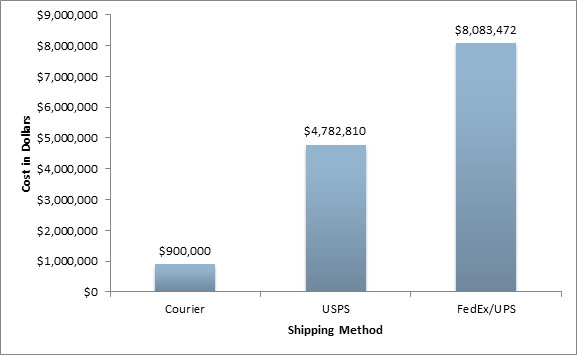The Colorado Library Courier System, managed by the Colorado Library Consortium (CLiC), provides delivery service for hundreds of libraries (academic, public, school, and special) across the state. Participating libraries pay for courier service based on the number of days they use the service per week as well as their shipping volume. This service saves libraries from the hassle and expense of turning to other alternatives if such an option did not exist. In such a scenario, libraries would presumably need to hire a commercial service such as FedEx, United Parcel Service (UPS), or the United States Postal Service (USPS) to transport materials. Two previous studies that compared the costs of these services to the courier cost demonstrated that the courier system does indeed provide substantial cost savings to participating libraries.[note]Lance, K.C. (2003). Courier service by regional systems saves libraries millions of dollars annually over alternative delivery methods. http://www.lrs.org/documents/fastfacts/191_courier.pdf; Lietzau, Z. (2007). Statewide courier saves libraries thousands in shipping costs each year. http://www.lrs.org/documents/fastfacts/251_courier.pdf[/note]
To update these results, the Library Research Service (LRS) conducted a study in Fall 2011 to determine the quantity and type of materials that libraries were sending via the courier system, and then to estimate, based on these numbers, the system’s cost effectiveness versus using a commercial service. All courier libraries were asked to participate in the study by tracking their courier use for 1 week, either September 26-30 or October 3-7, 2011. During this time period, 372 libraries were part of the courier system, 284 of which were eligible for participation in the study.[note]The remaining 88 libraries were community stops, which send and receive items via a courier library.[/note] A total of 193 (68%) of these submitted data.
Annual Courier Traffic
The data reported by the participating libraries was extrapolated[note]Extrapolation was based on population for academic, public, and school libraries. Population figures for special libraries were not available; therefore, these libraries were considered to be equivalent for the purposes of this study.[/note] and annualized to estimate the total number of materials shipped per year for all 284 libraries. The results indicated that there was a high volume of traffic moving through the courier system: an estimated 5.9 million items annually. As Table 1 shows, more than two-thirds of these items were books (68.7%), followed by DVDs (16.0%), audio books (6.7%), and music CDs (6.2%). “Other” materials (VHS tapes, etc.) made up just 1.5 percent of the traffic, and copies/correspondence and packages accounted for less than 1 percent each. An estimated 25,320 of the total number of materials (less than 1%) were courtesy returns.
Table 1
Estimated Annual Number of Materials by Type
All Courier Libraries (284)
 The estimated total weight for these materials—which was calculated by using the average weights for each material type (books, DVDs, etc.)—was 2.5 million pounds.
The estimated total weight for these materials—which was calculated by using the average weights for each material type (books, DVDs, etc.)—was 2.5 million pounds.
Estimated Annual Shipping Costs
LRS then calculated the shipping costs—which are based on weight—if libraries were to use USPS Library Mail, FedEx Ground, or UPS Ground[note]These services were chosen because they were equivalent to the courier service in terms of shipping time, and were the cheapest options for the commercial providers.[/note] instead of the courier system. Based on these annualized estimates, the courier system saves Colorado libraries millions of dollars each year (see Chart 1). The statewide courier costs $900,000[note]Figure provided by CLiC.[/note] annually for all 284 libraries, whereas USPS’s library mail service would cost an estimated $4.7 million, and FedEx Ground/UPS Ground[note]At the time of the study, FedEx Ground and UPS Ground had the same rates.[/note] would cost more than $8 million.
It is important to note that the cost savings realized by using the courier service extend beyond the shipping fees. If libraries used a commercial service, they would also incur costs for packing materials (e.g., boxes, bubble wrap, shipping labels, tape, etc.) and the additional staff time needed to pack the materials. In contrast, materials are packed in bins to be shipped via the courier service, meaning that minimal packing materials and less staff time are required.
Chart 1
Estimated Annual Shipping Costs
All Courier Libraries (284)

Conclusion
This study demonstrates that Colorado libraries experience significant cost savings by using the statewide courier. By providing a cost-effective means for transporting materials, this service enables libraries of all sizes to share items from their collections, and enhances the number and types of resources available to patrons.
It is important to remember that the numbers presented here are estimates. The annual figures are calculated based on data provided by a sample of courier libraries during a 1-week time period. There is a fair amount of diversity among the courier libraries that might not have been fully captured by the sample of libraries that chose to participate in the study, as well as fluctuation in traffic patterns from week to week. Therefore, the actual figures for materials transported and commercial shipping costs may vary a bit in either direction. However, it is reasonable to conclude that the courier saves Colorado libraries millions of dollars in shipping costs each year.
